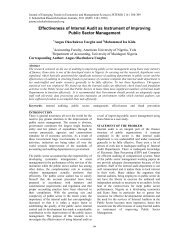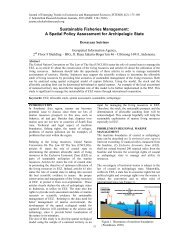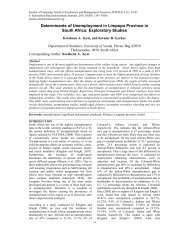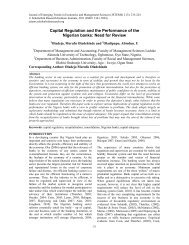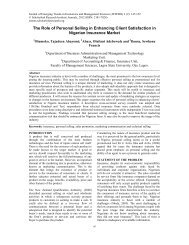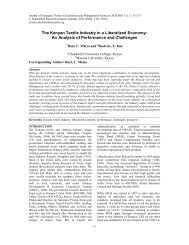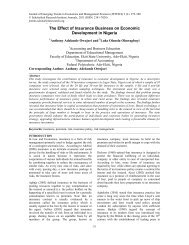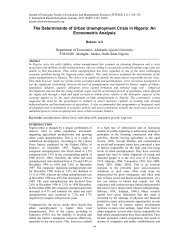Fraud as a Negative Catalyst in the Nigerian Banking Industry
Fraud as a Negative Catalyst in the Nigerian Banking Industry
Fraud as a Negative Catalyst in the Nigerian Banking Industry
You also want an ePaper? Increase the reach of your titles
YUMPU automatically turns print PDFs into web optimized ePapers that Google loves.
Journal of Emerg<strong>in</strong>g Trends <strong>in</strong> Economics and Management Sciences (JETEMS) 2 (5): 357-363© Scholarl<strong>in</strong>k Research Institute Journals, 2011 (ISSN: 2141-7024)Journal jetems.scholarl<strong>in</strong>kresearch.orgof Emerg<strong>in</strong>g Trends Economics and Management Sciences (JETEMS) 2(5):357-363 (ISSN:2141-7024)<strong>Fraud</strong> <strong>as</strong> a <strong>Negative</strong> <strong>Catalyst</strong> <strong>in</strong> <strong>the</strong> <strong>Nigerian</strong> Bank<strong>in</strong>g <strong>Industry</strong>Ak<strong>in</strong>dele R.IDepartment of Management and account<strong>in</strong>gObafemi Awolowo University, Ile Ife, Nigeria___________________________________________________________________________Abstract<strong>Fraud</strong> <strong>in</strong> <strong>the</strong> <strong>Nigerian</strong> Bank<strong>in</strong>g <strong>Industry</strong> before <strong>the</strong> recent merger and acquisition and recapitalisation effortsw<strong>as</strong> at alarm<strong>in</strong>g rate. It h<strong>as</strong> caused many banks to collapse, and many <strong>in</strong>vestors and depositors funds weretrapped <strong>in</strong>. Infact it h<strong>as</strong> prevented many banks from achiev<strong>in</strong>g <strong>the</strong>ir goals and many bus<strong>in</strong>esses went <strong>in</strong>toliquidation. Honestly speak<strong>in</strong>g it h<strong>as</strong> become a cankerworm that h<strong>as</strong> eat<strong>in</strong>g deep <strong>in</strong>to <strong>the</strong> vibric of <strong>the</strong> f<strong>in</strong>ancialsector of <strong>the</strong> <strong>Nigerian</strong> economy. That calls for <strong>the</strong> need for this study and <strong>the</strong> purpose of this study <strong>the</strong>refore isto identify <strong>the</strong> causes of fraud, me<strong>as</strong>ure it’s impact and identify means of controll<strong>in</strong>g. The study is a surveyresearch and questionnaire w<strong>as</strong> used for <strong>the</strong> collection of primary data while libraries, journals, write-ups,sem<strong>in</strong>ar papers and books by popular authors were used for secondary data. The f<strong>in</strong>d<strong>in</strong>gs show that lack ofadequate tra<strong>in</strong><strong>in</strong>g, communication gap, and poor leadership skills were <strong>the</strong> greatest causes of fraud <strong>in</strong> <strong>Nigerian</strong>bank<strong>in</strong>g <strong>in</strong>dustry. It w<strong>as</strong> concluded that adequate <strong>in</strong>ternal control system should be put <strong>in</strong> place and thatworkers satisfaction and comfort should be tak<strong>in</strong>g care off.__________________________________________________________________________________________Keywords: fraud, catalyst, effectiveness, efficiency and <strong>Nigerian</strong> economy__________________________________________________________________________________________INTRODUCTIONThe level of fraud <strong>in</strong> Nigeria before <strong>the</strong> latest reformh<strong>as</strong> <strong>as</strong>sumed an epidemic dimension. It h<strong>as</strong> eatendeep <strong>in</strong>to every <strong>as</strong>pect of life to <strong>the</strong> extent that even athree year old child talks about ‘419’, <strong>the</strong> newlydiscovered sobriquet for Advance fees fraud, which ishaunt<strong>in</strong>g us <strong>as</strong> a nation. The problem of frauds andeven forgeries are endemic and spread<strong>in</strong>g likeharmattan fire <strong>in</strong> <strong>the</strong> bank<strong>in</strong>g <strong>in</strong>dustry. In Nigeria,frauds have <strong>as</strong>sumed a frightened scale andsophisticated consequent upon <strong>the</strong> general economicand depression of <strong>the</strong> l<strong>as</strong>t decade. Over <strong>the</strong> l<strong>as</strong>tdecade, <strong>the</strong> growth <strong>in</strong> <strong>the</strong> rate of occurrence of frauds(successful and unsuccessful attempts have beenshock<strong>in</strong>g Bolton and Hand (2002). Oludifipe (1994)stated that even though <strong>the</strong> <strong>in</strong>dustry is becom<strong>in</strong>gmore militant and vigilant, millions of naira is stilllost on a daily b<strong>as</strong>is. He attributes <strong>the</strong> mostsignificant percentage of <strong>the</strong>se frauds to collusionbetween staff of banks and <strong>the</strong> fraudsters, whichconstitutes a very serious economic crime.Shongotola (1994) likens <strong>the</strong> Nigeria bank<strong>in</strong>g<strong>in</strong>dustry to “not just a battle front with a clear cutfir<strong>in</strong>g l<strong>in</strong>e between banks and bandits but a veritablem<strong>in</strong>e field <strong>in</strong> which some banks and <strong>the</strong>ir topmanagement staff are <strong>in</strong> secret leagues with <strong>the</strong>enemy”. He says that only <strong>the</strong> me<strong>as</strong>ured alertness andcollaboration of genu<strong>in</strong>e banks toge<strong>the</strong>r withimproved supervisory me<strong>as</strong>ures from CBN ad NDICwill term<strong>in</strong>ate such pirate organizations. As it werefrauds seem to have <strong>in</strong>cre<strong>as</strong>ed <strong>as</strong> new technology isborn and more advanced techniques of enhanc<strong>in</strong>gbus<strong>in</strong>ess transactions have been developed.<strong>Fraud</strong>sters are constantly devis<strong>in</strong>g new plans,357updat<strong>in</strong>g old methods and try<strong>in</strong>g out new techniquesof byp<strong>as</strong>s<strong>in</strong>g <strong>the</strong>se electronic systems meant to ensurehigh security of bank<strong>in</strong>g operations. The<strong>in</strong>troductions of automated systems that losehandwrit<strong>in</strong>g and f<strong>in</strong>gerpr<strong>in</strong>t trails have not helpedmatters ei<strong>the</strong>r.In view of <strong>the</strong> stagger<strong>in</strong>g sums lost to fraudsters by<strong>the</strong> <strong>Nigerian</strong> f<strong>in</strong>ancial sector, <strong>in</strong> <strong>the</strong>se recent timesand <strong>the</strong> rate at which fraudsters appear to have shifted<strong>the</strong>ir attention and directed <strong>the</strong>ir energies to banks,devis<strong>in</strong>g all unimag<strong>in</strong>able tactics to exploit loopholes<strong>in</strong> <strong>the</strong> control me<strong>as</strong>ures and capitalize on carelessnessof <strong>the</strong> staff and customers, <strong>Fraud</strong> <strong>in</strong> <strong>the</strong> <strong>in</strong>dustry h<strong>as</strong>prevented many banks from achiev<strong>in</strong>g <strong>the</strong>ir goals.Some banks were just seen <strong>in</strong> <strong>the</strong> physical <strong>as</strong> bodyand build<strong>in</strong>g <strong>the</strong>y were already liquidated and manywere already <strong>in</strong>to distress. Tak<strong>in</strong>g a walk downmemory lane, one can name a number of banks thatwound up distressed due to fraud. There is, <strong>the</strong>refore,a great need to study <strong>the</strong> changes and consequent offraud perpetrated <strong>in</strong> <strong>the</strong> bank<strong>in</strong>g <strong>in</strong>dustry and to lookfor ways 0f prevent<strong>in</strong>g fraud hav<strong>in</strong>g realized that Is itreally possible to have a fraud free bank<strong>in</strong>g <strong>in</strong>dustry<strong>in</strong> Nigeria.The focus of <strong>the</strong> study is to identify and <strong>as</strong>sess <strong>the</strong>causes, consequences, detection, prevention andcontrol of fraud <strong>in</strong> <strong>the</strong> Nigeria Bank<strong>in</strong>g <strong>Industry</strong>.LITERATURE REVIEW AND THEORETICALFRAME WORKYoung, (2002) says that, ample evidence exists that<strong>in</strong>dividual <strong>in</strong>tegrity of those runn<strong>in</strong>g <strong>the</strong> banks today
Journal of Emerg<strong>in</strong>g Trends <strong>in</strong> Economics and Management Sciences (JETEMS) 2(5):357-363 (ISSN:2141-7024)h<strong>as</strong> never been at a higher level. Never before havewe seen attention to <strong>the</strong> actual steps; procedures andcontrol of monetary transactions. Employees’ <strong>as</strong> well<strong>as</strong> firms <strong>in</strong> all <strong>in</strong>dustries engage <strong>in</strong> fraudulentpractices all over one world. Although <strong>the</strong> existenceof fraud <strong>in</strong> our banks is not an uncommon orunexpected behaviour, <strong>the</strong> prevalence ‘of it is what isworry<strong>in</strong>g because of all <strong>the</strong> various problemsconfront<strong>in</strong>g <strong>the</strong> most untraceable’. (Ogwuma, 1985)and Ak<strong>in</strong>dele R.I el al (2008).<strong>Fraud</strong>s <strong>in</strong> banks early lead to loss of monies thatord<strong>in</strong>arily belong to someone o<strong>the</strong>r than <strong>the</strong> banks.The loss results <strong>in</strong> some ce<strong>as</strong>es <strong>in</strong> reduc<strong>in</strong>g <strong>the</strong> levelof resources available for use <strong>in</strong> <strong>the</strong> operations of <strong>the</strong>banks. In very bad c<strong>as</strong>es where frauds occur withcrippl<strong>in</strong>g frequency and <strong>in</strong> wholesomeness, <strong>the</strong> bankmay be forced to close down <strong>as</strong> a result. When <strong>the</strong>bank loses money and is wound up, <strong>the</strong> customerslose money. This leads to loss of confidence andeventually reduced patronage. Ano<strong>the</strong>r re<strong>as</strong>on forworry<strong>in</strong>g <strong>in</strong> <strong>the</strong> bank<strong>in</strong>g <strong>in</strong>dustry is <strong>the</strong> v<strong>as</strong>t variety ofnature, character and methodology employed <strong>in</strong>fraud. Moreover, <strong>the</strong> control of identified specieseems to give birth to ano<strong>the</strong>r that is <strong>in</strong>variably moresophisticated and complex. Thus each c<strong>as</strong>e can besaid to be a variant of ano<strong>the</strong>r and undoubtedly an<strong>in</strong>structive study <strong>in</strong> human negative use of <strong>in</strong>genuityand endowment.Crosse and Hempel (1973) and Canhil M el al (2002)had identified five major types of fraud perpetrated <strong>in</strong><strong>the</strong> bank<strong>in</strong>g <strong>in</strong>dustry. These <strong>in</strong>clude; “Borrow<strong>in</strong>g” from <strong>the</strong> till. This usually starts outwith borrow<strong>in</strong>g a few naira, which are returned.Overtime, <strong>the</strong> sums <strong>in</strong>volved <strong>in</strong>cre<strong>as</strong>e and <strong>the</strong>will<strong>in</strong>gness ad ability to ‘repay’ decl<strong>in</strong>es. Forgeries of customers’ signature to withdrawfrom his/her account. Transfer from customers account to collaboratorsaccount. Grant<strong>in</strong>g of loans to fictitious borrowers. Grant<strong>in</strong>g of loans without adequate <strong>in</strong>formationand security from <strong>the</strong> borrower.There are two ma<strong>in</strong> sources of frauds <strong>in</strong> banks – <strong>the</strong><strong>in</strong>ternal source ad external. Though dist<strong>in</strong>guishable <strong>in</strong><strong>the</strong>ory, <strong>the</strong>se sources are very often <strong>in</strong>separable <strong>in</strong>practice. That is to say, a successful fraud often takesplace and succeeds <strong>as</strong> a result of <strong>the</strong> collaboration<strong>in</strong>tentional or un<strong>in</strong>tentional (i.e due to carelessness orerror of judgment, of an <strong>in</strong>sider – a bank employee ormember of staff).Indeed it w<strong>as</strong> recently affirmedthat” <strong>the</strong> public believes and rightly too, that mostfrauds <strong>in</strong> banks are <strong>the</strong> active connivance of bankstaff. O<strong>the</strong>rwise how does anybody expla<strong>in</strong> forexample, how a cheque drawn <strong>in</strong> favour of <strong>the</strong>Federal Government of Nigeria is paid <strong>in</strong>to someprivate account and <strong>the</strong> funds withdrawn? Or howdoes one expla<strong>in</strong> how a completely different<strong>in</strong>stitution or <strong>in</strong>dividual collects a draft prepared <strong>in</strong><strong>the</strong> name of an <strong>in</strong>stitution or <strong>in</strong>dividual? This is notan exception of <strong>the</strong> rule, it is frequent occurrence”(Soneye, 1985), Botton et al (2002)The sources of bank fraud can also be cl<strong>as</strong>sified <strong>in</strong>to<strong>in</strong>stitutional factors, lapses or <strong>in</strong>adequacies andenvironmental/societal factors, lapses, Adewunmi,(1985), Cahill, Chen and Lambert (2002) andHul<strong>the</strong>n R et al (2002).Institutional factors/lapses/<strong>in</strong>adequacies are factorsthat we can trace to <strong>the</strong> <strong>in</strong>ternal environment of <strong>the</strong>organization. They are, to a great extent, factorswith<strong>in</strong> <strong>the</strong> control of <strong>the</strong> management of <strong>the</strong> bank.The major <strong>in</strong>stitutional source of fraud is poormanagement. This is often manifested <strong>in</strong> variousways. Lack of adequate supervision is a manifestationof poor management. Also <strong>in</strong>adequate control <strong>in</strong> <strong>the</strong>form of effective policies, procedures and systems is<strong>in</strong>dicative of poor management (Biscaia, AlexiouPavon and Hul<strong>the</strong>n 2002).Socio economic lapses/<strong>in</strong>adequacies: The bank is an<strong>in</strong>tegral part of society. It is affected by <strong>as</strong> well <strong>as</strong> itaffects <strong>the</strong> elements <strong>in</strong> its immediate and remoteenvironment. If <strong>the</strong> wrote society of which <strong>the</strong> bankis a part, is morally bankrupt, it will be difficult, ifnot impossible to expect <strong>the</strong> banks to be <strong>in</strong>sulatedfrom <strong>the</strong> effects of such moral decadence. Oursocieties have deb<strong>as</strong>ed <strong>the</strong> entire old moral standardsand appear to be unconcerned with probity, honesty,<strong>in</strong>tegrity and “goodname”. The family friends, <strong>the</strong>religious houses and society at large seem not to carehow you come about your riches but accept,accommodate and even respect you for your wealth,however, dishonesty it h<strong>as</strong> been acquired. All <strong>the</strong>seencourage fraud <strong>as</strong> <strong>the</strong> end seems to justify <strong>the</strong>means, and no means seems to be morallyunacceptable.Nature and Types of <strong>Fraud</strong><strong>Fraud</strong>s <strong>in</strong> f<strong>in</strong>ancial <strong>in</strong>stitutions vary widely <strong>in</strong> naturecharacter and method of perpetrations. But <strong>in</strong> general,fraud can be cl<strong>as</strong>sified <strong>in</strong>to; perpetrators and methodused on <strong>the</strong> b<strong>as</strong>is of perpetrators, three categories arenoted, namely: - <strong>in</strong>ternal, external and mixedperpetrations. Internal perpetrators are made up of <strong>the</strong>staff, external perpetrators refer to outsiders notconnected with <strong>the</strong> <strong>in</strong>stitution, mixed refers to acollusion between <strong>the</strong> staff and external parties.Cl<strong>as</strong>sification of fraud by method used is <strong>the</strong> mostcommon form of cl<strong>as</strong>sification employed by f<strong>in</strong>ancial<strong>in</strong>stitutions; <strong>the</strong> list is <strong>in</strong> exhaustive <strong>as</strong> fraudsters on adaily b<strong>as</strong>is are devis<strong>in</strong>g new methods. The follow<strong>in</strong>gare <strong>the</strong> most important and common types of fraudhighlighted by Bank Adm<strong>in</strong>istration Institute (1989)<strong>in</strong> <strong>Fraud</strong> prevention and Detection series.Advanced Fees <strong>Fraud</strong>: Popularly known <strong>as</strong> ‘419’,advanced fees fraud may <strong>in</strong>volve an gent with an358
Journal of Emerg<strong>in</strong>g Trends <strong>in</strong> Economics and Management Sciences (JETEMS) 2(5):357-363 (ISSN:2141-7024)offer of a bus<strong>in</strong>ess proposition which would lead toaccess often for a long term. The source of funds orbus<strong>in</strong>ess is not specific and can only be reachedthrough <strong>the</strong> agent who does so for a commission.Once <strong>the</strong> commission is paid <strong>the</strong> agent disappears<strong>in</strong>to th<strong>in</strong> air.Account Open<strong>in</strong>g <strong>Fraud</strong>: This <strong>in</strong>volves a depositand c<strong>as</strong>h<strong>in</strong>g of fraudulent cheques. An <strong>in</strong>dividual<strong>as</strong>k<strong>in</strong>g to open a transaction account at anunsuspect<strong>in</strong>g bank with false identification papersunknown to <strong>the</strong> bank does it.Cheque Kit<strong>in</strong>g: Kit<strong>in</strong>g, <strong>as</strong> def<strong>in</strong>ed by us comptrollerof <strong>the</strong> currency’s policy guidel<strong>in</strong>es for national BankDirectors, is a method whereby a depositor utilizes<strong>the</strong> time required for cheques to dear to obta<strong>in</strong> anunauthorized loan without any <strong>in</strong>terest charge’. Thegoal of <strong>the</strong> kiter may be to use <strong>the</strong>se uncontrolledfunds, <strong>in</strong>terest free, for a short time to overcome atemporary c<strong>as</strong>h shortage or to withdraw fundspermanently for personal use.Cheque <strong>Fraud</strong>: Most common c<strong>as</strong>es of this k<strong>in</strong>d offraud are through stolen cheques and forgedsignatures. This is very popular because cheques areused daily and are not too hard to come by. Mosttimes, this type of fraud does not require collusionand can sometimes go understand unless <strong>the</strong>perpetrator gets greedy.Clear<strong>in</strong>g <strong>Fraud</strong>: This is a fraud perpetrated <strong>in</strong> <strong>the</strong>clear<strong>in</strong>g of cheques. It is done by suppression of an<strong>in</strong>strument so that at <strong>the</strong> expiration of <strong>the</strong> clear<strong>in</strong>gperiod applicable to <strong>the</strong> <strong>in</strong>strument, <strong>the</strong> collect<strong>in</strong>gbank will give value <strong>as</strong> through <strong>the</strong> pay<strong>in</strong>g bank hadconf<strong>in</strong>ed <strong>the</strong> <strong>in</strong>strument good for payment.Misrout<strong>in</strong>g of clear<strong>in</strong>g cheques can also <strong>as</strong>sistfraudsters to complete a clear<strong>in</strong>g fraud.Counterfeit Securities: This is one of <strong>the</strong> oldestforms of crime. Documents, securities, bonds andcertificate could be forged, duplicated, adjusted oraltered and presented for loan collection. Equallytre<strong>as</strong>ury notes, c<strong>as</strong>hiers cheques, bankers acceptance,certificate of deposit <strong>in</strong> an altered form could bepresented to banker redemption.Computer <strong>Fraud</strong>: This could be perpetrated by <strong>the</strong>corruption of a programme, hack<strong>in</strong>g, tamper<strong>in</strong>g witha diskette to ga<strong>in</strong> access to unauthorized are<strong>as</strong> andgive credit to an account for which <strong>the</strong> funds were notorig<strong>in</strong>ally <strong>in</strong>tended.Loan <strong>Fraud</strong>: This is perpetrated when funds are lentto a non-borrow<strong>in</strong>g customer or a borrow<strong>in</strong>gcustomer that h<strong>as</strong> exceeded his credit limit. In mostc<strong>as</strong>es <strong>the</strong> staff are <strong>the</strong> perpetrators like <strong>the</strong> c<strong>as</strong>hiersand <strong>the</strong>y hide this from <strong>the</strong> management.Money launder<strong>in</strong>g fraud: This is a means to conceal<strong>the</strong> existence, source or use of illegal obta<strong>in</strong>ed moneyby convert<strong>in</strong>g <strong>the</strong> c<strong>as</strong>h <strong>in</strong>to untraceable transactions<strong>in</strong> banks. The c<strong>as</strong>h is disguised to make <strong>the</strong> <strong>in</strong>comeappear legitimate and is usually done by collusion ofa customer with a member of staff.Money Transfer <strong>Fraud</strong>: <strong>Fraud</strong>ulent money transfermay result from a request solely for <strong>the</strong> purpose ofcommitt<strong>in</strong>g a fraud or <strong>the</strong> alteration of a genu<strong>in</strong>efunds transfer request. This can be done by chang<strong>in</strong>gnames, adjust<strong>in</strong>g figures or account numbers. Thisform of fraud is made e<strong>as</strong>y for fraudsters because of<strong>the</strong> e<strong>as</strong>e at which <strong>the</strong>y can be dare e.g mail,telephone, electronic process, telex and even <strong>the</strong>latest technology of us<strong>in</strong>g GSM phones.Telex <strong>Fraud</strong>: The messages that are p<strong>as</strong>sed throughtelex <strong>in</strong> form of codes could be altered to divert <strong>the</strong>funds to ano<strong>the</strong>r account.Letters of Credit: Most common <strong>in</strong> <strong>in</strong>ternationaltrad<strong>in</strong>g, <strong>the</strong>se are <strong>in</strong>struments used across borders adscan be forged, altered, adjusted and take longer toidentify. So, <strong>in</strong> most c<strong>as</strong>es, perpetrators escape.METHODSIn understand<strong>in</strong>g this work, two types of data wererelied upon, namely primary and secondary. On <strong>the</strong>primary data, structured questionnaire were designedand constructed to ga<strong>the</strong>r <strong>in</strong>formation <strong>in</strong> realiz<strong>in</strong>g <strong>the</strong>objectives of <strong>the</strong> research. For secondary data, <strong>the</strong>researcher relied mostly on archival materials,<strong>in</strong>ternal records of banks, Publications of bank staff,Sem<strong>in</strong>ar papers,The population for this study w<strong>as</strong> 6 banks; 3orthodox and new generation. Six banks were <strong>the</strong>nselected; three orthodox namely: First bank, Nationalbank and Wema bank and three new-generationbanks. The essence of divid<strong>in</strong>g <strong>the</strong> bank<strong>in</strong>g <strong>in</strong>dustry<strong>in</strong>to two is to critically <strong>as</strong>sess any differences orvariances <strong>in</strong> <strong>the</strong> types, causes, and detection methodsand control me<strong>as</strong>ures of fraud. Also to see if <strong>the</strong>orthodox banks with <strong>the</strong>ir old methods are successful<strong>in</strong> reduc<strong>in</strong>g fraud, to see <strong>the</strong> variation <strong>in</strong> <strong>the</strong>ir lossesand <strong>the</strong> effects.The new generation banks are also looked at to see if<strong>the</strong> excessive reliance on computer andtechnologically complex mach<strong>in</strong>ery is not ano<strong>the</strong>rcause of <strong>the</strong> <strong>in</strong>cre<strong>as</strong>e <strong>in</strong> fraud <strong>in</strong> banks. The samplesize of <strong>the</strong> study consists of 50 subjects, which werechosen from simple random method.RESULTInformation ga<strong>the</strong>red from <strong>the</strong> research <strong>as</strong> perresponses towards fraud <strong>in</strong> <strong>the</strong> <strong>Nigerian</strong> bank<strong>in</strong>g<strong>in</strong>dustry <strong>in</strong> terms of total scores, mean score, standarderror, standard deviation, variance were shown <strong>in</strong>table 1(see appendices). Table 1 shows a summary of<strong>the</strong> variables. Us<strong>in</strong>g <strong>the</strong> mean statistic we can say thattra<strong>in</strong><strong>in</strong>g is <strong>the</strong> strongest variable and so <strong>the</strong> lack ofadequate tra<strong>in</strong><strong>in</strong>g is a major cause of fraud.Inadequate communication channel is ano<strong>the</strong>r majorcause of fraud. This is followed by weak leadershipstyles of supervisors and managers. From thissummary we can deduce that <strong>in</strong>adequate tra<strong>in</strong><strong>in</strong>g h<strong>as</strong><strong>the</strong> greatest impact compared with weak leadershipstyle and poor communication. The result w<strong>as</strong> testedfur<strong>the</strong>r us<strong>in</strong>g analysis of variance (ANOVA) to359
Journal of Emerg<strong>in</strong>g Trends <strong>in</strong> Economics and Management Sciences (JETEMS) 2(5):357-363 (ISSN:2141-7024)determ<strong>in</strong>e <strong>the</strong> difference between means <strong>as</strong> shown <strong>in</strong>table 2.Table 3 shows that irregular tra<strong>in</strong><strong>in</strong>g comb<strong>in</strong>ed withpoor leadership skills is <strong>the</strong> stronger comb<strong>in</strong>ation ofvariables caus<strong>in</strong>g fraud. The ANOVA <strong>in</strong> table 4shows that communication gap <strong>in</strong> comb<strong>in</strong>ation with<strong>in</strong>adequate tra<strong>in</strong><strong>in</strong>g <strong>as</strong> strongest <strong>in</strong>fluence with<strong>in</strong> <strong>the</strong>group. Although between groups <strong>the</strong> comb<strong>in</strong>ation ofpoor leadership skills <strong>as</strong> well <strong>as</strong> <strong>in</strong>adequate tra<strong>in</strong><strong>in</strong>gare <strong>the</strong> strongest communication channelThe central bank of Nigeria recorded various c<strong>as</strong>esof frauds <strong>as</strong> presented <strong>in</strong> table 5.On <strong>the</strong> contrary, <strong>the</strong> <strong>Nigerian</strong> Deposit <strong>in</strong>surancecorporations (NDIC) annual report shows somevariations <strong>in</strong> <strong>the</strong> estimate over <strong>the</strong> l<strong>as</strong>t number ofyears. In 1998, 1999, 2000 and 2001, <strong>the</strong> money’slost to fraud were recorded <strong>as</strong> N689.2m, N2730.57m,N2851.11m and N11, 243.98m respectively. TheNDICS’ report on frauds for <strong>the</strong> quarter endedSeptember 2002 revealed that <strong>the</strong> <strong>in</strong>cidence of frauds<strong>in</strong> banks is on <strong>the</strong> <strong>in</strong>cre<strong>as</strong>e. In all, banks reported 415fraud and forgery c<strong>as</strong>es valued at about N15,274billion between June and September 2002. Aconsolidated report on fraud and forgeries collated by<strong>the</strong> committee of chief <strong>in</strong>spectors show that a total of292 fraud attempts were made on banks <strong>in</strong> Nigeriafrom January 2000 to September 2000. The amount<strong>in</strong>volved w<strong>as</strong> seven billion naira.There have also been compiled reports from <strong>Nigerian</strong>commercial and merchant banks. In 1996, a decl<strong>in</strong>ew<strong>as</strong> recorded from 606 c<strong>as</strong>es to 487 <strong>in</strong> 1997, <strong>the</strong>amount; however, rose from N1, 600.82m <strong>in</strong> 1996Nigeria recorded <strong>the</strong> follow<strong>in</strong>g c<strong>as</strong>es <strong>as</strong> shown <strong>in</strong>table 6. From <strong>the</strong> table above, <strong>the</strong>re w<strong>as</strong> a rapid<strong>in</strong>cre<strong>as</strong>e <strong>in</strong> <strong>the</strong> amount of money actually lost eventhough <strong>the</strong> number of c<strong>as</strong>es fell from 612 <strong>in</strong> 1998 to403 <strong>in</strong> 2000 and skyrocketed <strong>in</strong> 2001 but fell aga<strong>in</strong> to628 <strong>in</strong> 2002. Even with <strong>the</strong> reduced number of c<strong>as</strong>es,<strong>the</strong> amount lost <strong>in</strong>cre<strong>as</strong>ed rapidly except for a fallfrom N1,243.55m <strong>in</strong> 1996 to N788.87m <strong>in</strong> 1997 and<strong>the</strong>n from N7.404b <strong>in</strong> 1999 to N906.3m <strong>in</strong> 2000. On<strong>the</strong> contrary, <strong>the</strong> <strong>Nigerian</strong> deposit <strong>in</strong>surancecorporations (NDIC) annual report shows somevariation <strong>in</strong> <strong>the</strong> estimates from 1998 to 2002. Theseestimates were N689.2m <strong>in</strong> 1998, N2730.57m <strong>in</strong>1999, N2851.11m <strong>in</strong> 2000, N11, 243.98m <strong>in</strong> 2001and N15.274b <strong>in</strong> 2002 <strong>in</strong>dict<strong>in</strong>g a steady butstagger<strong>in</strong>g <strong>in</strong>cre<strong>as</strong>e <strong>in</strong> money lost to fraudsters.Surpris<strong>in</strong>gly, a consolidated report of fraud andforgeries collated by <strong>the</strong> committee of chief<strong>in</strong>spectors show that a total of 292 fraud attemptsamounted to N7b <strong>in</strong> 2000 alone. There have also beencompiled reports from <strong>Nigerian</strong> commercial andmerchant banks show<strong>in</strong>g at first a decl<strong>in</strong>e <strong>in</strong> no ofc<strong>as</strong>es from 606 <strong>in</strong> 1996 to 487 <strong>in</strong> 1997 but an<strong>in</strong>cre<strong>as</strong>e <strong>in</strong> amount lost from N1, 600.82 to N3,777.90m. <strong>the</strong>n a rise <strong>in</strong> no of c<strong>as</strong>es to 573 but adecl<strong>in</strong>e <strong>in</strong> <strong>the</strong> amount of N3,196.57 <strong>in</strong> 1998 <strong>the</strong>n toN7.404b <strong>in</strong> 1999.In <strong>the</strong> l<strong>as</strong>t four to five years, <strong>the</strong> number of c<strong>as</strong>es offraud h<strong>as</strong> decl<strong>in</strong>ed but <strong>the</strong> amounts lost <strong>in</strong> <strong>the</strong>se fewerc<strong>as</strong>es are dev<strong>as</strong>tat<strong>in</strong>g. First, Bank of Nigeria, one of<strong>the</strong> old timers, recorded <strong>the</strong> c<strong>as</strong>es <strong>in</strong> table 7.Look<strong>in</strong>gat <strong>the</strong> estimates above, <strong>in</strong> 1999, <strong>the</strong> number of c<strong>as</strong>eswere 95 amount<strong>in</strong>g to N248.34b but fell to 69 c<strong>as</strong>esamount<strong>in</strong>g to N169.12b <strong>in</strong> 2000 and fell aga<strong>in</strong> <strong>in</strong>2001 t0 54 c<strong>as</strong>es amount<strong>in</strong>g to N128.17b. Year 2002saw an <strong>in</strong>cre<strong>as</strong>e <strong>in</strong> c<strong>as</strong>es to 61 and also an <strong>in</strong>cre<strong>as</strong>e <strong>in</strong>amount to N231.54b and <strong>the</strong>n ano<strong>the</strong>r fell <strong>in</strong> 2003 <strong>in</strong><strong>the</strong> amount lost to N212.7b even though number ofc<strong>as</strong>es <strong>in</strong>cre<strong>as</strong>ed to 66. From <strong>the</strong> tables, leadershipstyles could be a serious cause or <strong>in</strong>fluence on <strong>the</strong>impact to perpetrate fraud. Also, communication,some respondents felt <strong>the</strong> lack of <strong>in</strong>adequatecommunication channels is also a determ<strong>in</strong>ant of <strong>the</strong>level or rate of fraud <strong>in</strong> <strong>the</strong> bank<strong>in</strong>g <strong>in</strong>dustry. Inaddition, <strong>the</strong> lack of tra<strong>in</strong><strong>in</strong>g and proper skills is <strong>the</strong>strongest factor caus<strong>in</strong>g fraud. This stems from <strong>the</strong><strong>in</strong>ability of <strong>the</strong> staff to effectively carry out a job.Tra<strong>in</strong><strong>in</strong>g creates an awareness of possible techniquesby which a fraudster could carry out his activities.Therefore, <strong>the</strong> lack of tra<strong>in</strong><strong>in</strong>g enhances <strong>the</strong> avenuefor fraud because people are not skillfully equippedto handle and tackle fraud. Also <strong>the</strong>y are unable torecognize <strong>the</strong> <strong>in</strong>tent to perpetrate even when it isquite glar<strong>in</strong>g. Tra<strong>in</strong><strong>in</strong>g is a very vital <strong>as</strong>pect ofbus<strong>in</strong>ess, to keep with chang<strong>in</strong>g times and evolv<strong>in</strong>gtechnology. Just <strong>in</strong> <strong>the</strong> same way <strong>as</strong> technologyevolves and develops; fraudsters are evolv<strong>in</strong>g newtechniques and develop<strong>in</strong>g more crafty ways to getaway with huge sums of money. <strong>Fraud</strong>, which h<strong>as</strong>been on <strong>the</strong> <strong>in</strong>cre<strong>as</strong>e at an alarm<strong>in</strong>g rate h<strong>as</strong>accord<strong>in</strong>gly ga<strong>in</strong>ed <strong>the</strong> <strong>in</strong>cre<strong>as</strong><strong>in</strong>g attention of <strong>the</strong>government, monetary and supervisory authorities <strong>in</strong>view of <strong>the</strong> fact that frauds result <strong>in</strong> huge f<strong>in</strong>anciallosses <strong>in</strong> banks, <strong>the</strong>ir customers, <strong>the</strong> depletion ofshareholders’ fund and capital b<strong>as</strong>e and loss ofconfidence <strong>in</strong> <strong>the</strong> f<strong>in</strong>ancial system which mayultimately precipitate failure of <strong>the</strong> sector.This study identifies those actors or elements thatcause fraud. It looks at motivational factors such <strong>as</strong>f<strong>in</strong>ancial <strong>in</strong>centives, promotions and bonuses <strong>as</strong> well<strong>as</strong> leaves and leave-allowances. The absence of suchmotivational factors could lead to dissatisfaction andaccord<strong>in</strong>g to <strong>the</strong> differential <strong>as</strong>sociation <strong>the</strong>ory offraud, <strong>the</strong> member of staff sees <strong>the</strong> benefits offperpetrat<strong>in</strong>g fraud <strong>as</strong> more favourable than hispresent position and this pushes him to commit <strong>the</strong>fraud. Look<strong>in</strong>g at <strong>the</strong> impact of fraud on profits,reputation and customer confidence, <strong>the</strong> occurrenceof fraud h<strong>as</strong> <strong>in</strong>evitably reduced <strong>the</strong> profits mak<strong>in</strong>g.Also, <strong>the</strong>re were c<strong>as</strong>es where <strong>the</strong> CBN comes <strong>in</strong> toregulate activities and even sometimes w<strong>in</strong>d up <strong>the</strong>bank<strong>in</strong>g operatives of some banks.360
Journal of Emerg<strong>in</strong>g Trends <strong>in</strong> Economics and Management Sciences (JETEMS) 2(5):357-363 (ISSN:2141-7024)Fur<strong>the</strong>rmore, various controls were recognized, forexample, proper recruitment procedures, dualcustody, logs and registers, segregation of duties datavalidation, call over of posted entries, sign<strong>in</strong>gpowers, c<strong>as</strong>h limits physical checks and counts,program controls and prompt post<strong>in</strong>g of transactions.The cause of fraud were also revealed, such c<strong>as</strong>es <strong>as</strong>employee dissatisfaction, negligence, carelessness of<strong>the</strong> customer, relaxed security controls, <strong>in</strong>adequaterecord keep<strong>in</strong>g methods and lose security over highrisk are<strong>as</strong> like computer files. The study also revealedhow professional personnel detect those nefariousacts and f<strong>in</strong>ally <strong>the</strong> mechanisms put <strong>in</strong> place toprevent and control <strong>the</strong> occurrence of fraud such <strong>as</strong><strong>the</strong> Regis cope camera to take pictures of anyonecollect<strong>in</strong>g very substantial amount of money. Also, itrevealed that some banks use staff rotation <strong>as</strong> ameans of prevent<strong>in</strong>g fraud.CONCLUSIONIn view of <strong>the</strong> craze for money, and <strong>the</strong> prevail<strong>in</strong>gharsh economic environment, big time frauds are on<strong>the</strong> <strong>in</strong>cre<strong>as</strong>e <strong>in</strong> Nigeria. Banks are los<strong>in</strong>g amountsrunn<strong>in</strong>g <strong>in</strong>to millions of naira to fraudsters on a dailyb<strong>as</strong>is <strong>in</strong> most c<strong>as</strong>es, when <strong>the</strong> frauds are detectedearly, amounts already drawn are usually difficult torecover. Even where bank <strong>in</strong>spectors discover fraudand <strong>the</strong>re is <strong>the</strong> possibility of recover<strong>in</strong>g some of <strong>the</strong>frauds, <strong>the</strong> cooperation of <strong>the</strong> police h<strong>as</strong> not beenparticularly encourag<strong>in</strong>g. Also <strong>in</strong> some c<strong>as</strong>es toplevels of management that do not want negativepublicity for <strong>the</strong> bank try to smoo<strong>the</strong>n certa<strong>in</strong> c<strong>as</strong>es.Time is <strong>the</strong>refore of essence <strong>in</strong> effect<strong>in</strong>g control offrauds. A sound and effective control system will notonly prevent fraud but will at an early stage detect it.In a nutshell, <strong>the</strong> impact of fraud is so great that allhands must be on deck to ensure that <strong>the</strong>re are noloopholes for perpetrators. Even though, fromstudies, it is ga<strong>the</strong>red that for <strong>as</strong> long <strong>as</strong> <strong>Nigerian</strong>s aremoney crazy, <strong>the</strong>re will always be fraudsters, one canonly attempt to m<strong>in</strong>imize fraud <strong>in</strong> <strong>the</strong> bank<strong>in</strong>g<strong>in</strong>dustry. It is my op<strong>in</strong>ion that bank can only reduce<strong>the</strong> occurrence of fraud by ensur<strong>in</strong>g conclusive,satisfactory and comfortable work<strong>in</strong>g conditions ofstaff and also to prepare for <strong>the</strong> <strong>in</strong>evitability of <strong>the</strong>occurrence so <strong>as</strong> not to loose too much operat<strong>in</strong>g timewhilst deal<strong>in</strong>g with <strong>the</strong> occurrence.RECOMMENDATIONAs banks are to <strong>in</strong>cre<strong>as</strong>e <strong>the</strong>ir requirements perta<strong>in</strong><strong>in</strong>gto qualifications; draw up more efficient screen<strong>in</strong>gtechniques, <strong>as</strong>certa<strong>in</strong> that references are not fictitiousat <strong>the</strong> recruitment stages. Also ensure that <strong>the</strong>re issegregation of duties, efficient <strong>in</strong>ternal controls, jobssatisfactions and job enrichment. The t<strong>as</strong>k of bankmanagement is challeng<strong>in</strong>g enough without <strong>the</strong> eventpresent risk of fraud, so awareness should also becreated so <strong>as</strong> to ‘nip’ <strong>the</strong> situation <strong>in</strong> <strong>the</strong> ‘bud’ beforeanyth<strong>in</strong>g serious occurs. This requires more than justsound judgment and dynamic action; it calls forcommitment that can only be ga<strong>in</strong>ed if <strong>the</strong>management h<strong>as</strong> ensured that all <strong>the</strong> motivational<strong>in</strong>centives have been put <strong>in</strong> place. A total alertnessthat takes noth<strong>in</strong>g for granted and awareness that trustcould be misplaced, this be<strong>in</strong>g a diligent andpa<strong>in</strong>stak<strong>in</strong>g approach.Fur<strong>the</strong>rmore, tra<strong>in</strong><strong>in</strong>g techniques should be upgradedto test honesty and <strong>in</strong>tegrity and not just technicalskills. This should entail extensive tra<strong>in</strong><strong>in</strong>gprogramme regularly done, <strong>as</strong> well <strong>as</strong> personalitytests and IQ tests so <strong>as</strong> to understand <strong>the</strong> personalityand character of <strong>the</strong> tra<strong>in</strong>ee. This would reducenegligence and carelessness <strong>in</strong> carry<strong>in</strong>g out b<strong>as</strong>icprocedures that could pose <strong>as</strong> loopholes for fraud.REFERENCESAk<strong>in</strong>dele R.I, N<strong>as</strong>sar M.L and Owolabi A.A. (2008)Essentials of Research methodology ObafemiAwolowo University Publisher, Ile- Ife.Almah F. Saaid, K<strong>in</strong>g, R., Nur. Darfiana: (2009)Development of Users’ call profiles us<strong>in</strong>gunsupervised Random forest. Conference proceed<strong>in</strong>g,Third Annual ASEARC Dec. 7-8, Newc<strong>as</strong>tle,AustraliaBank Adm<strong>in</strong>istration Institute (1989) <strong>Fraud</strong>prevention and detection seriesBiscaia H, Alexion .S, Pavon .F,and Hul<strong>the</strong>nR.(2002) “Do <strong>in</strong>telligent techniques aid <strong>Fraud</strong>detection?. Eurescon project ReportsBiscaia H., Alexiou S., Pavon F. and Hul<strong>the</strong>n R.(2002) “Do <strong>in</strong>telligent techniques aid fraud detection?Eurescon project Reports. March.Bolton R.J., Hand D.J.: (2002) Statistical frauddetection: A review Statistical Science 17(3) 235-249.Cahill.M, Chen F,and Lambert D ,P<strong>in</strong>heiro. J,andSun. D. (2002) ”Detect<strong>in</strong>g <strong>Fraud</strong> <strong>in</strong> <strong>the</strong> Real World”Handbook of M<strong>as</strong>sive Dat<strong>as</strong>ets, Kluewer.Cortesao L., Mart<strong>in</strong>s F.: Rosa A., Carvallio P. (2005)“<strong>Fraud</strong> Management Systems <strong>in</strong>Telecommunications”: A practical Approach. ICTFMSCrosse H.D and Hempel. G.H. (1973) Managementpolitics for commercial banks pp 242-245Faweett T. and Provost F.,(1996) “Comb<strong>in</strong>g DataM<strong>in</strong><strong>in</strong>g and Mach<strong>in</strong>e Learn<strong>in</strong>g for Effective Userprofil<strong>in</strong>g”. Second International Conference onKnowledge Discovery and Data M<strong>in</strong><strong>in</strong>g, August.361
Journal of Emerg<strong>in</strong>g Trends <strong>in</strong> Economics and Management Sciences (JETEMS) 2(5):357-363 (ISSN:2141-7024)M. J. Comer (1985) Corporate fraud McGraw HillBook Co. UK.Ogwuma P.A (1985) Problems and prospects of <strong>the</strong>Nigeria Bank<strong>in</strong>g <strong>in</strong>dustry. Sem<strong>in</strong>ar by: <strong>the</strong> f<strong>in</strong>ancial<strong>in</strong>stitutions tra<strong>in</strong><strong>in</strong>g centre. Pp5-7Olufidipe, E.O. (1994); <strong>Fraud</strong> <strong>in</strong> <strong>the</strong> <strong>Nigerian</strong>economy and it’s implications for banks & f<strong>in</strong>ancial<strong>in</strong>stitutions. The <strong>Nigerian</strong> Banker July-December pp7-10Paper on <strong>Fraud</strong>s: prevention/control (2001) Regionalmanagers’ conference First Bank of Nigeria, PlcArchivesRosa A., Carvalho P.: (2005) <strong>Fraud</strong> managementsystems <strong>in</strong> Telecommunications: a practice approach,<strong>in</strong>: proceed<strong>in</strong>g of ICT.Shongotola, I.O. (1994); fraud detection and control.Nigeria Banker July-December pp16-19.Soneye O.O (1985) Paper on sem<strong>in</strong>ar organized byf<strong>in</strong>ancial <strong>in</strong>stitutions tra<strong>in</strong><strong>in</strong>g centre p5.Team R.: (2009) A language and environment forstatistical Comput<strong>in</strong>g.Young M . R. (2002) Account<strong>in</strong>g Irregularities andf<strong>in</strong>ancial fraud. Pp 1-9 Publishers: Aspen law andBus<strong>in</strong>ess, Aspen Publishers Inc. NY.APPENDIXESTable 1: Show<strong>in</strong>g Mean Score, Standard Error, Standard Deviation, Variance & RangeA Summary of <strong>the</strong> Variables.Variables Mean Stat. Std Error Std Deviation Variance RangeCommunication 2.2600 9.394 E-02 0.642 0.4412 2.00F<strong>in</strong>ancial <strong>in</strong>centives 1.6800 6.664 E-02 0.4712 0.2220 1.00Job satisfaction 2.0800 8.963 E-02 0.6337 0.4016 2.00Leadership 2.1400 8.086 E-02 0.5718 0.3269 2.00Motivation 1.7000 6.547 E-02 0.4629 0.2143 1.00Tra<strong>in</strong><strong>in</strong>g 2.8200 0.1300 0.9190 0.8445 3.00Source survey research 2007Table 2: ANOVA Table Show<strong>in</strong>g Statistical Summary of VariablesSource: Survey 2007Sum OfSquaresDegree ofReedomMeanSqareFSigCommunication Between groups (Comb<strong>in</strong>ed) 1.591 1 1.591 3.812 0.057L<strong>in</strong>ear term Unweighted 1.591 1 1.591 3.812 0.057Weighted 1.591 1 1.591 3.812 0.057Job satisfactionWith<strong>in</strong> groups 20.029 48 0.417Total 21.620 49Between groups0.272 1 0.272 0672 0.416(Comb<strong>in</strong>ed)L<strong>in</strong>ear term Weighted 0.272 1 0.272 0.672 0.416Unweighted 0.272 1 0.272 0.672 0.416With<strong>in</strong> groups 19.408 48 0.404Total 19.680 49Table 4: Show<strong>in</strong>g Statistical Relationship between Leadership, Job Satisfaction, Communication and Tra<strong>in</strong><strong>in</strong>gSum of squares df Mean square F Sig.Leadership * tra<strong>in</strong><strong>in</strong>g Between groups (Comb<strong>in</strong>ed) 1.417 3 .472 1.488 .230With<strong>in</strong> group 14.603 46 .317Job satisfaction *tra<strong>in</strong><strong>in</strong>gCommunication *tra<strong>in</strong><strong>in</strong>gTotal 16.020 49Between groups (Comb<strong>in</strong>ed) .536 3 .179 .429 .733With<strong>in</strong> group 19.144 46 .416Total 19.680 49Between groups (Comb<strong>in</strong>ed) .415 3 .138 .300 .825With<strong>in</strong> group 21.205 46 .461Total 21.620 49Source: Survey Research, 2007362
Journal of Emerg<strong>in</strong>g Trends <strong>in</strong> Economics and Management Sciences (JETEMS) 2(5):357-363 (ISSN:2141-7024)Table 3: Report Show<strong>in</strong>g Comparison of Tra<strong>in</strong><strong>in</strong>g aga<strong>in</strong>st Leadership, Job Satisfaction and CommunicationTra<strong>in</strong><strong>in</strong>g Leadership Job satisfaction CommunicationQuarterly Mean 2.0000 2.0000 2.0000N 5 5 5Std. Deviation .4472 .0000 .7071Std. Error of Mean .2000 .0000 .3162Sum 11.00 10.00 10.00Every six months Mean 2.2727 2.1818 2.2727N 11 11 11Std. Deviation .7862 .6030 .6467Std. Error of Mean .2371 .1818 .1950Sum 25.00 24.00 25.00Annual Mean 1.9545 2.1364 2.3182N 22 22 22Std. Deviation .4857 .6396 .7162Std. Error of Mean .1036 .1364 .1527Sum 43.00 47.00 51.00O<strong>the</strong>rs Mean 2.3333 1.9167 2.2500N 12 12 12Std. Deviation .4924 .7930 .6216Std. Error of Mean .1421 .2289 .1794Sum 28.00 23.00 27.00Total Mean 2.1400 2.0800 2.2600N 50 50 50Std. Deviation .5718 .6337 .6642Std. Error of Mean 8.086E-02 8.963E-02 9.394E-02Sum 107.00 104.00 113.00Source: Survey 2007Table 5Year Number Of Reported C<strong>as</strong>es Amount Involved1994 675 N842.68m1995 657 N 3621.01m1996 403 N 1,243.55m1997 414 N 788.87m1998 612 N 3,993.46m1999 573 N 7.404b2000 403 N 906.3m2001 981 N 5.0b2002 628 N 12.696b(Bank<strong>in</strong>g Supervision Annual Report 1998& 2003)Table 6Year Number Of Reported C<strong>as</strong>es Amount Involved1996 403 N 1,243.55m1997 414 N 788.87m1998 612 N 3,993.46m1999 573 N 7.404b2000 403 N 906.3m2001 981 N 5.0b2002 628 N 12.696b(Bank<strong>in</strong>g supervision Annual Report 1998& 2003)Table 7Year No Of C<strong>as</strong>es Amounts Involved1999 95 N 248.34b2000 69 N 169.12b2001 54 N 128.17b2002 61 N 231.54b2003 66 N 212.77b(First Bank of Nigeria Plc Archives)363




